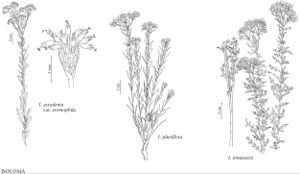Isocoma
Trans. Amer. Philos. Soc., n. s. 7: 320. 1840.
| Taxon | Illustrator ⠉ | |
|---|---|---|
 | Isocoma acradenia var. eremophila Isocoma pluriflora Isocoma tenuisecta | Barbara Alongi Barbara Alongi Barbara Alongi |
Perennials or subshrubs, (4–) 20–120 (–150) cm (bases often woody). Stems usually strictly erect, few-branched, glabrous or hispidulous, villous, or tomentose, usually gland-dotted (sessile or slightly sunken in pits), sometimes stipitate-glandular, rarely eglandular, often resinous. Leaves mostly cauline; alternate; sessile; blades 1-nerved, linear to oblanceolate or obovate, margins entire or toothed to pinnatifid (teeth or lobes often spinulose-tipped), faces glabrous or hispidulous, villous, or tomentose, usually gland-dotted (in pits). Heads discoid, (sessile or subsessile) in compact clusters borne in terminal corymbiform arrays, rarely borne singly. Involucres obconic to turbinate or campanulate, (3–9.5 ×) 2–8 mm. Phyllaries 15–30 in (3–) 4–6 series, 1-nerved (midnerves usually barely evident; flat to convex), oblong to elliptic-lanceolate, unequal, margins narrowly scarious, apices sometimes green, faces glabrous or tomentose, sometimes gland-dotted, sometimes with resin pockets. Receptacles flat, pitted, epaleate. Disc-florets 8–34, bisexual, fertile; corollas yellow with dark orange-resinous veins, tubes (with at least a few glandular-hairs) longer than abruptly ampliate, goblet-shaped throats (tube elevating corollas above involucres at flowering), lobes 5, erect, deltate (elongating at maturity, unequal, outer prominently bent or leaning outward, abruptly enlarged); style-branch appendages narrowly triangular. Cypselae (brownish) obpyramidal, terete or subterete, 5–11-ribbed (sometimes thick and resinous), faces sericeous; pappi persistent, of 40–50 unevenly thick, unequal, barbellate, apically attenuate bristles in 2 (–3) series. x = 6.
Distribution
sw United States, Mexico
Discussion
Species 16 (10 in the flora).
Isocoma is recognized by its subshrubby habit, gland-dotted (sometimes stipitate-glandular), often resinous leaves, compactly clustered discoid heads in terminal, corymbiform arrays, goblet-shaped disc corollas, and base chromosome number of x = 6. H. M. Hall (1928) regarded the group as a section of Haplopappus, as did A. Cronquist (1994). Naturally occurring hybrids in south-central Mexico have been observed between Isocoma veneta (Kunth) Greene and Xanthocephalum humile (Kunth) Bentham (R. L. Hartman and M. A. Lane 1991).
Selected References
Lower Taxa
Key
| 1 | Phyllary apices with strongly developed resin pockets | > 2 |
| 1 | Phyllary apices gland-dotted (rarely so in I. coronopifolia), lacking resin pockets or pockets small, weakly developed | > 3 |
| 2 | Teeth or lobes of leaf margins apically rounded-obtuse; florets 8–27; phyllary apices not spinulose-aristate, or if spinulose-aristate, then florets 20–27 | Isocoma acradenia |
| 2 | Teeth or lobes of leaf margins apically spinulose; florets 10–13; phyllary apices spinulose-aristate | Isocoma arguta |
| 3 | Leaves pinnatifid | > 4 |
| 3 | Leaves entire or shallowly toothed to lobed, not pinnatifid | > 6 |
| 4 | Herbage minutely hispidulous or sparsely puberulous (at least distal stems) | Isocoma tenuisecta |
| 4 | Herbage glabrous | > 5 |
| 5 | Involucres 5–7.5 mm wide; florets 18–25 | Isocoma azteca |
| 5 | Involucres 2.5–4 mm wide; florets 12–15 | Isocoma coronopifolia |
| 6 | Phyllary apices distinctly aristate-spinulose; florets 10–13; California | Isocoma arguta |
| 6 | Phyllary apices not aristate-spinulose; florets 8–34; California and eastward | > 7 |
| 7 | Involucres 3.2–7 × 2.5–4 mm; florets 8–17(–21) | > 8 |
| 7 | Involucres 5–9 × 4.5–8 mm; florets (15–)18–34 | > 9 |
| 8 | Leaves never stipitate-glandular but almost always resinous, glabrous; involucres 5–7 mm | Isocoma coronopifolia |
| 8 | Leaves sometimes stipitate-glandular, never resinous, margins hispidulous, sometimes also on faces; involucres 3.2–5.5 mm | Isocoma pluriflora |
| 9 | Leaves 5–10(–18) mm; corollas 4–5 mm | Isocoma humilis |
| 9 | Leaves (in I. menziesii 5–)13–50 mm; corollas 5–7.5 mm | > 10 |
| 10 | Leaf margins entire or toothed to lobed; California | Isocoma menziesii |
| 10 | Leaf margins entire; e of California | > 11 |
| 11 | Involucres (5.5–)6–9.5 × 5–7.5 mm; phyllary apices yellowish to greenish yellow, sparsely or not at all gland-dotted; florets 19–25, corollas 5–6.5 mm; cypsela ribs forming hornlike extensions; Arizona, Colorado, New Mexico, Utah | Isocoma rusbyi |
| 11 | Involucres (5.5–)6.5–8 × 4.5–5.5(–7) mm; phyllary apices usually green, usually densely gland-dotted; florets (18–)22–34, corollas 5.8–7.5 mm; cypsela ribs not forming hornlike extensions; Texas | Isocoma drummondii |
"thick" is not a number."[" is not declared as a valid unit of measurement for this property."]" is not declared as a valid unit of measurement for this property.